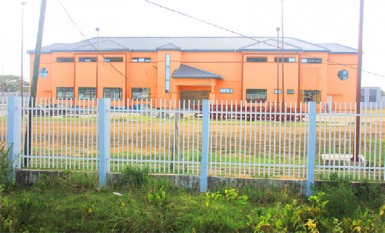The electrical fire at the billion dollar Guyana Forensic Science Labora-tory (GFSL) located at Turkeyen was a hazard waiting to happen says a US-based contractor who refused remedial works on the building.
“The electrical works on that building cannot pass international building codes because of a host of faults with the wiring, beginning from the low amp wires used to the inferior quality materials,” the contractor who requested anonymity told Stabroek News in a telephone interview from the United States.
Last Sunday APNU+AFC executive Nigel Hughes posted on social media that there was an electrical fire in the building. He said that the fire started in a socket with the buildup so intense that it blew out a glass wall which separated the technical room from the rest of the floor.
According to Hughes the fire also caused the other outlets on the same floor to be burnt.

The Ministry of Home Affairs admitted that there was a fire on March 17, at the building but said that Hughes’ account of the incident was “exaggerated.”
“It is true that the Guyana Forensic Science Laboratory was subject to a minor electrical fire on the evening of March 17, 2015, but the facts are being exaggerated by Mr Hughes,” read the press statement.
It went on further, “Additionally, contrary to Mr Hughes’ claims that the fire ‘burnt all the electrical outlets on the rest of the floor,’ it should be noted that only a small fraction of electrical outlets were actually affected and these are being replaced.”
The MOHA stated that the fire was caused due to the proximity of a chair to an outlet when the outlet itself burned due to an electrical surge and a problem which developed in a phase in one of the main cables.
While Hughes stated that the ministry was advised prior to the fire that the electrical installation in the building was faulty and poor the MOHA dismissed these claims saying it never received such a warning. Moreover, it said that upon completion of the electrical installation at the GFSL, the contractor produced a Certificate of Inspection.
This was disputed by the overseas electrical contractor who said he told the ministry about the faults.
“I explained to them when I was inspecting the place for proposed remedial works on the electrical system that there were many faults.
For example the conduits were overloaded where you are supposed to only have two live and two neutral wires there were six,” he said.
“In most of the places and on that same floor with the technical room they are using 15 amp lines.
“Any electrician would tell you that you don’t use 15 amps for commercial wiring and that building had to be wired not to meet domestic specifications but commercial,” the man added.
He said he refused the job because no one listened to his cautions on the work executed.
“The work there is [poor] that’s the long and short of it and someone has to be held responsible. Your building won’t pass any code and that’s why when electricians come here with accreditation from Guyana they are made to redo so that they obtain US certification. It is sad but true,” the source said.
Hughes had also stated that the air flow quality at the building was poor as it recirculates toxic fumes and has caused staff to fall ill.
The ministry explained that it should not be held responsible for this aspect of faults as it is a problem created by the design consultant against whom it has now filed court litigation.
“Whilst this process is ongoing, consultations are being made with regard to identifying a temporary solution for correcting the air flow,” the ministry stated.
“These issues, while regrettable, cannot be attributed to negligence on the part of the ministry and by extension the Government of Guyana, thus the ministry rejects the allegations made in the release by Mr Hughes,” it added.
The $1.049 billion lab, which was funded by the Inter-American Development Bank (IDB) was commissioned on July 14 last year, at which time it was stated that in addition to conducting a broad range of tests, a section of the sprawling 12, 000-ft complex will be used as a training ground for science students of the University of Guyana.
Rohee had said that the lab would not be another white elephant and that it was that at every stage of its development it is active and “taking business in order to drive its professionalism.” The lab, he stressed is expected “to be a revenue stream for the government of Guyana” adding that the various scientific tests will be offered to clients locally and at a later stage internationally.
He said the facility is outfitted with “state-of-the-art” equipment including highly specialized systems which will keep track of all evidence submitted for analysis.





